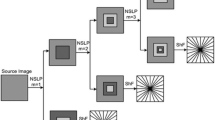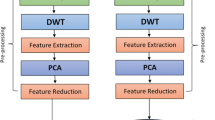Abstract
The automatic diagnosis of breast cancer (BC) is an important, real-world medical problem. This paper proposes a design of automated detection, segmentation, and classification of breast cancer nuclei using a fuzzy logic. The first step is based on segmentation using an active contour for cell tracking and isolating of the nucleus in the cytological image. Then from this nucleus, have been extracted some textural features using the wavelet transforms to characterize image using its texture, so that malign texture can be differentiated from benign one with the assumption that tumoral texture is different from the texture of other kinds of tissues. Finally, the obtained features will be introduced as the input vector of a fuzzy C-means (FCM) clustering algorithm to classify the images into malign and benign ones. The implementation of such algorithm has been done using a methodology based on very high speed integrated circuit, hardware description language (VHDL). The design of the circuit is performed by using a CMOS 0.35 μm technology.











Similar content being viewed by others
References
Street, W. N. (1991). Toward automated cancer diagnosis: an interactive system for cell feature extraction. Technical Report 1052, Computer Sciences Department, University of Wisconsin, Madison, WI, October.
Street, W. N. (2000). Xcyt: A system for remote cytological diagnosis and prognosis of breast cancer. In L. C. Jain (Ed.), Soft computing techniques in breast cancer prognosis and diagnosis (pp. 297–322). Singapore: World Scientific Publishing.
Wolberg, W. H., & Street, W. N. (2002). Computer-generated nuclear features compared to axillary lymph node status and tumor size as indicators of breast cancer survival. Human Pathology, 33(11), 1086–1091 Nov.
Lee, K., & Street, W. N. (2003). A time- and memory-efficient algorithm for automated segmentation of breast cancer nuclei. Journal of Korea Information Science Society, 30(9–10), 973–982 October (in Korean).
Chi, C.-L., Street, W. N., & Wolberg, W. H. (2007). Application of artificial neural network-based survival analysis on two breast cancer datasets. American Medical Informatics Association Annual Symposium (AMIA 2007), pp. 130–134, Chicago, IL, November.
Malek, J. (2000). Contribution à l’étude des classifieurs neuro-flous: applications à la reconnaissance vocale de l’arabe et au diagnostic médical. these, FSM, Monastir.
Mabrouk, S., Malek, J., & Tourki, R. (2005). Cytological image wavelet-texture-based feature extraction. Third International Conference on Systems, Signals & Devises.
Malek, J., Abid, M., Torki, K., & Tourki, R. (2001). Design of an efficient fuzzy clustering algorithm for breast cancer diagnosis. Smart Systems and Devices, pp. 413–418. Publication (ISBN: 9973-31-926-5).
Sebri, A. (2005). Conception of system for treatment of cytological image of breast cancer. Master’s Project specialty Microelectronics. Faculty of sciences Monatir, Tunisia.
Zizzari, A., Seiffert, U., Michaelis, B., Gademann, G., & Swiderski, S. (2001). Detection of tumor in digital images of the brain. Proceedings of the IASTED International conference, Signal processing, pattern recognition & applications; Greece, July.
Russ, J. C. (1999). The image processing handbook (3rd ed.). Florida: CRC Press.
Karahaliou, A., Skiadopoulos, S., Boniatis, I., Sakellaropoulos, P., Likaki, E., Panayiotakis, G., et al. (2007). Texture analysis of tissue surrounding microcalcifications on mammograms for breast cancer diagnosis. British Journal of Radiology, 80, 648–656.
Yu, S. N., Li, K. Y., & Huang, Y.-K. (2006). Detection of microcalcifications in digital mammograms using wavelet filter and Markov random field model. Computerized Medical Imaging and Graphics, 30(3), 163–173 April.
Karahaliou, A., Boniatis, I., Sakellaropoulos, P., Skiadopoulos, S., Panayiotakis, G., & Costaridou, L. (2007). Can texture of tissue surrounding microcalcifications in mammography be used for breast cancer diagnosis? Nuclear Instruments and Methods in Physics Research Section A: Accelerators, Spectrometers, Detectors and Associated Equipment, 580(2), 1071–1074 1 October.
Bharati, M. H., Liu, J. J., & Macgregor, J. F. (2004). Image texture analysis: Methods and comparisons. Elsevier, Chemometrics and Intelligent Laboratory Systems, 72, 57–71.
Mokni, M. (2004). Data base of ctytological image of breast cancer, cytology and anatopathology service. Sousse, Tunisia: CHU Farhat Hached.
Kass, M., Witkin, A., & Terzopoulos, D. (1988). Snakes: Active contour models. International Journal of Computer Vision, 1(4), 321–331.
Gunn, S. R., & Nixon, M. S. (1997). A robust snake implementation; a dual active contour. IEEE Transactions on Pattern Analysis and Machine Intelligence, 19(1), 63–68 January.
Bulpitt, A. J., & Efford, N. D. (1996). An efficient 3D deformable model with self-optimising mesh. Image and Vision Computing, 14, 573–580.
Xu, C., & Prince, J. L. (1998). Generalized gradient vector flow external forces for active contours. Signal Processing, An International Journal, 71(2), 131–139 December.
Xu, C., & Prince, J. L. (2000). Global optimality of gradient vector flow. Proc. of 34th Annual Conference on Information Sciences and Systems (CISS’00), Princeton University, March.
Sharma, M., Markou, M., &, Singh, S. (1980). Evaluation of texture methods for image analysis. Pattern Recognition Letters.
Shim, S.-O., & Choi, T.-S. (2003). Image indexing by modified color co-occurrence matrix. ICIP 2003, IEEE 2003.
Misiti, M., Oppenheim, G., & Poggi, J.-M. (1996). Wavelet toolbox for use with Matlab, the MathWorks. MA: Natick.
Elmalek, J., & Tourki, R. (1998). New algorithm for solving the fuzzy clustering problem. 2nd IMACS International Multiconference. Computational Engineering in Systems Applications, 4, 908–911.
Elmalek, J., &, Tourki, R. (1999). A speaker independent Arabic isolated spoken digits recognition system using fuzzy Kohonen clustering network. In A. Dobnikar, N. C. Steele, D. W. Pearson, & R. F. Albrecht (Eds.), Artificial neural nets and genetic algorithms (pp. 111–115). Springer Verlag.
Elmalek, J., Alimi, A. M., & Tourki, R. (2000). Evolution of the generalization error of fuzzy classifiers with the size of the feature vector. Acidca’2000 International Conference on Artificial and Computational Intelligence for Decision, Control and Automation in Engineering and Industrial Applications, Tunisia, pp. 37–41.
Elmalek, J., Abid, M., Torki, K., &, Tourki, R. (2001). Design of an efficient fuzzy clustering algorithm for breast cancer diagnosis. Smart Systems and Devices, 413–418.
Elmalek, J., Alimi, A. M., & Tourki, R. (2002). On problems in pattern classification in high-dimensional spaces: behavior of a class of combined neuro-fuzzy classifiers. Fuzzy Set and System, 128(1), 15–33 16 May. Published by Elsevier Science.
Bezdek, J. C. (1973). Fuzzy mathematics in pattern classification, PhD dissertation, Center for Applied Mathematics. Ithaca, NY: Cornell University.
Bezdek, J. C. (1981). Pattern recognition with fuzzy objective function algorithms. New York: Plenum.
Balmelli, L., & Mojsilovic, A. (1999). Wavelet domain features for texture description, classification and replicability analysis. Proceedings of IEEE International Conference on Image Processing (ICIP), 4, 440–444 October.
Abid, M., Mtibaa, A., & Tourki, R. (1998). Architecture reconfigurable pour le prototypage des systèmes électroniques. 5ème colloque Canadien sur les circuits programmables (SPD98), pp. 55–59, 7–10 Juin, Canada.
Gajski, D. D., & Ramachandran, L. (1994). Introduction to high-level synthese. IEEE Design and Test of Computers, Hiver.
Acknowledgments
This work based upon work supported by the French–Tunisian cooperation (Rhône-Alpes/Monastir).
Author information
Authors and Affiliations
Corresponding author
Rights and permissions
About this article
Cite this article
Malek, J., Sebri, A., Mabrouk, S. et al. Automated Breast Cancer Diagnosis Based on GVF-Snake Segmentation, Wavelet Features Extraction and Fuzzy Classification. J Sign Process Syst Sign Image Video Technol 55, 49–66 (2009). https://doi.org/10.1007/s11265-008-0198-2
Received:
Revised:
Accepted:
Published:
Issue Date:
DOI: https://doi.org/10.1007/s11265-008-0198-2




